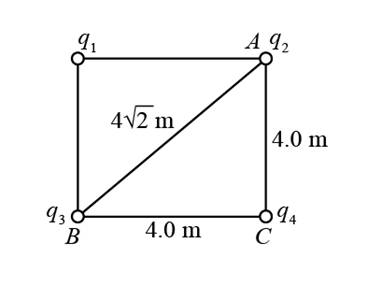
Concept explainers
(a)
The electrostatic potential energy of the system when all of the charges are negative.
(a)
Answer to Problem 68P
The electrostatic potential energy of the system when all of the charges are negative is
Explanation of Solution
Given Data:
The charge on each particle is
The side of a square is
Formula used:
The expression for the work required to assemble the system of charges which is equal to the potential energy of the system is given as,
Calculation:

Figure (1)
The electrostatic potential energy of the system is calculated as,
Conclusion:
Therefore, the electrostatic potential energy of the system when all of the charges are negative is
(b)
The electrostatic potential energy of the system when three of the charges are positive and one of the charge is negative.
(b)
Answer to Problem 68P
The electrostatic potential energy of the system when three of the charges are positive and one of the charge is negative is zero.
Explanation of Solution
Given Data:
The charge on three particles is
The charge on fourth particle is
The side of a square is
Formula used:
The expression for the work required to assemble the system of charges which is equal to the potential energy of the system is given as,
Calculation:
The electrostatic potential energy of the system is calculated as,
Conclusion:
Therefore the electrostatic potential energy of the system when three of the charges are positive and one of the charge is negative is zero.
(c)
The electrostatic potential energy of the system when two adjacent corners are positive and other two are negative
(c)
Answer to Problem 68P
The electrostatic potential energy of the system when two adjacent corners are positive and other two are negative is
Explanation of Solution
Given Data:
The charge on first particle is
The charge on second particle is
The charge on third particle is
The charge on fourth particle is
The side of a square is
Formula used:
The expression for the work required to assemble the system of charges which is equal to the potential energy of the system is given as,
Calculation:
The electrostatic potential energy of the system is calculated as,
Conclusion:
Therefore the electrostatic potential energy of the system when two adjacent corners are positive and other two are negative is
(d)
The electrostatic potential energy of the system when the charges at two opposite corners are positive and other two are negative.
(d)
Answer to Problem 68P
The electrostatic potential energy of the system when the charges at two opposite corners are positive and other two are negative is
Explanation of Solution
Given Data:
The charge on first particle is
The charge on second particle is
The charge on third particle is
The charge on fourth particle is
The side of a square is
Formula used:
The expression for the work required to assemble the system of charges which is equal to the potential energy of the system is given as,
Calculation:
The electrostatic potential energy of the system is calculated as,
Conclusion:
Therefore, the electrostatic potential energy of the system when the charges at two opposite corners are positive and other two are negative is
Want to see more full solutions like this?
Chapter 23 Solutions
EBK PHYSICS FOR SCIENTISTS AND ENGINEER
- Can someone help mearrow_forwardCan someone help me with this thank youarrow_forward(a) For a spherical capacitor with inner radius a and outer radius b, we have the following for the capacitance. ab C = k₂(b- a) 0.0695 m 0.145 m (8.99 × 10º N · m²/c²)( [0.145 m- 0.0695 m × 10-11 F = PF IIarrow_forward
- A pendulum bob A (0.5 kg) is given an initialspeed of vA = 4 m/s when the chord ishorizontal. It then hits a stationary block B (1kg) which then slides to a maximum distanced before it stops. Determine the value of d.The coefficient of static friction between theblock and the plane is μk = 0.2. The coefficientof restitution between A and B is e = 0.8.Ans: d=1.0034 marrow_forwardFigure 29-43 Problem 12. ••13 In Fig. 29-44, point P₁ is at distance R = 13.1 cm on the perpendicular bisector of a straight wire of length L = 18.0 cm carrying current i = 58.2 mA. (Note that the wire is not long.) What is the magnitude of the magnetic field at P₁ due to i? P2° R R Larrow_forwardCheckpoint 1 The figure shows the current i in a single-loop circuit with a battery B and a resistance R (and wires of neg- ligible resistance). (a) Should the emf arrow at B be drawn pointing leftward or rightward? At points a, B C R b, and c, rank (b) the magnitude of the current, (c) the electric potential, and (d) the electric potential energy of the charge carriers, greatest first.arrow_forward

 College PhysicsPhysicsISBN:9781285737027Author:Raymond A. Serway, Chris VuillePublisher:Cengage Learning
College PhysicsPhysicsISBN:9781285737027Author:Raymond A. Serway, Chris VuillePublisher:Cengage Learning Physics for Scientists and Engineers: Foundations...PhysicsISBN:9781133939146Author:Katz, Debora M.Publisher:Cengage Learning
Physics for Scientists and Engineers: Foundations...PhysicsISBN:9781133939146Author:Katz, Debora M.Publisher:Cengage Learning College PhysicsPhysicsISBN:9781938168000Author:Paul Peter Urone, Roger HinrichsPublisher:OpenStax College
College PhysicsPhysicsISBN:9781938168000Author:Paul Peter Urone, Roger HinrichsPublisher:OpenStax College Principles of Physics: A Calculus-Based TextPhysicsISBN:9781133104261Author:Raymond A. Serway, John W. JewettPublisher:Cengage Learning
Principles of Physics: A Calculus-Based TextPhysicsISBN:9781133104261Author:Raymond A. Serway, John W. JewettPublisher:Cengage Learning Glencoe Physics: Principles and Problems, Student...PhysicsISBN:9780078807213Author:Paul W. ZitzewitzPublisher:Glencoe/McGraw-Hill
Glencoe Physics: Principles and Problems, Student...PhysicsISBN:9780078807213Author:Paul W. ZitzewitzPublisher:Glencoe/McGraw-Hill





